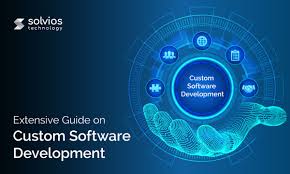Unlocking Business Potential Through Custom Software Development
The Power of Custom Software Development
In today’s fast-paced digital world, businesses are constantly seeking ways to stay ahead of the competition. One powerful tool that can give companies a competitive edge is custom software development.
Custom software development involves creating tailored applications or programs to meet specific business needs. Unlike off-the-shelf software, custom solutions are designed from the ground up to address unique challenges and requirements.
Benefits of Custom Software Development
Enhanced Efficiency: Custom software is built to streamline processes and workflows within an organization. By automating repetitive tasks and integrating various systems, businesses can operate more efficiently and save valuable time.
Scalability: Custom software can grow and evolve with your business. As your needs change or expand, developers can easily update or enhance the software to accommodate new requirements.
Competitive Advantage: By having a unique software solution tailored to your business, you can differentiate yourself from competitors. Custom software allows you to offer personalized services and experiences that set you apart in the market.
Challenges of Custom Software Development
Cost: Developing custom software can be more expensive upfront compared to off-the-shelf solutions. However, the long-term benefits and ROI often justify the initial investment.
Time-Consuming: Building custom software requires time for planning, development, testing, and implementation. It’s crucial to have a clear project timeline and realistic expectations regarding the development process.
Conclusion
Custom software development offers businesses a powerful tool for driving innovation, efficiency, and growth. By investing in tailored solutions that align with your unique goals and requirements, you can unlock new opportunities and propel your business forward in today’s digital landscape.
Top 5 Benefits of Custom Software Development for Your Business
- Tailored to specific business needs
- Enhanced efficiency and productivity
- Scalable to accommodate growth
- Provides a competitive advantage
- Offers personalized solutions and experiences
4 Drawbacks of Custom Software Development: Cost, Time, Delays, and Dependency
- Higher initial cost compared to off-the-shelf solutions
- Time-consuming development process
- Potential for project delays and scope creep
- Dependency on a specific development team for maintenance and updates
Tailored to specific business needs
Custom software development offers the significant advantage of being tailored to specific business needs. Unlike off-the-shelf solutions that provide generic functionalities, custom software is designed and built to address the unique challenges and requirements of a particular business. By aligning the software closely with the organization’s processes and goals, companies can optimize their operations, improve efficiency, and achieve a competitive edge in their industry. This tailored approach ensures that the software not only meets current needs but also has the flexibility to adapt and grow along with the business, supporting long-term success and innovation.
Enhanced efficiency and productivity
Enhanced efficiency and productivity are key advantages of custom software development. By creating tailored solutions that automate repetitive tasks, streamline processes, and integrate various systems, businesses can operate more efficiently. Custom software allows organizations to optimize their workflows, reduce manual errors, and save valuable time, ultimately leading to increased productivity across the board. This improved efficiency not only boosts operational performance but also empowers employees to focus on high-value tasks that drive business growth and innovation.
Scalable to accommodate growth
Custom software development offers the significant advantage of scalability, allowing businesses to easily accommodate growth and expansion. Unlike off-the-shelf solutions that may have limitations in scalability, custom software can be designed with flexibility in mind. This means that as a company evolves and its needs change, the custom software can be adapted and scaled up to meet new requirements seamlessly. By investing in scalable custom software, organizations can future-proof their technology infrastructure and ensure that their digital systems can grow alongside their business.
Provides a competitive advantage
Custom software development provides businesses with a significant competitive advantage by offering tailored solutions that are specifically designed to meet their unique needs and challenges. By having software that is customized to optimize processes, enhance productivity, and deliver personalized experiences to customers, companies can differentiate themselves in the market and stand out from competitors. This advantage allows businesses to stay ahead of the curve, adapt quickly to changing market conditions, and ultimately drive growth and success in their industry.
Offers personalized solutions and experiences
Custom software development stands out for its ability to offer personalized solutions and experiences tailored to the specific needs and requirements of a business. By creating custom software, companies can address unique challenges, streamline processes, and deliver services that are designed to meet the exact preferences of their target audience. This level of customization not only enhances user satisfaction but also helps businesses differentiate themselves in a competitive market by providing a unique and personalized experience that sets them apart from generic off-the-shelf solutions.
Higher initial cost compared to off-the-shelf solutions
One significant drawback of custom software development is the higher initial cost when compared to off-the-shelf solutions. Building a tailored software solution from scratch requires investment in planning, design, development, and testing processes, which can result in a substantial upfront expense for businesses. While the initial cost may be a barrier for some organizations, it’s essential to consider the long-term benefits and ROI that custom software can offer in terms of enhanced efficiency, scalability, and competitive advantage.
Time-consuming development process
One significant drawback of custom software development is the time-consuming nature of the development process. Building custom software requires thorough planning, coding, testing, and implementation, which can take a considerable amount of time. Delays in development can impact project timelines and potentially hinder business operations or strategic initiatives. It’s essential for organizations considering custom software solutions to factor in the time needed for development and ensure realistic expectations are set regarding the timeline for completion.
Potential for project delays and scope creep
One significant drawback of custom software development is the potential for project delays and scope creep. Due to the complex nature of building customized solutions, unforeseen challenges may arise during the development process, leading to timeline extensions and scope expansion. This can result in increased costs, resource allocation issues, and frustration among stakeholders. Effective project management and clear communication are essential to mitigate these risks and ensure the successful delivery of custom software projects within set timelines and budgets.
Dependency on a specific development team for maintenance and updates
One significant drawback of custom software development is the dependency on a specific development team for maintenance and updates. Since the software is uniquely tailored to the business’s needs, it often requires specialized knowledge and expertise to make changes or enhancements. This reliance on a specific team can pose challenges if the team becomes unavailable or if there are disagreements regarding maintenance costs or priorities. Businesses may find themselves limited in their options for ongoing support and updates, potentially leading to delays in addressing issues or implementing new features.





